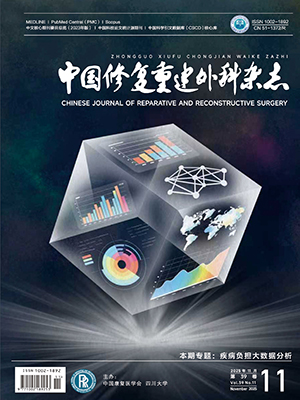| 1. |
刘国明, 黄富国, 秦廷武.巨大肩袖撕裂的治疗及研究进展.中国修复重建外科杂志, 2011, 25(1):61-65.
|
| 2. |
丁舒晨, 马超然, 王哲洋, 等.前列腺E2在肩袖损伤中作用的研究.中国骨与关节杂志, 2013, 2(12):712-715.
|
| 3. |
Contreras F, Brown HC, Marx RG.Predictors of success of corticosteroid injection for the management of rotator cuff disease.HSS J, 2013, 9(1):2-5.
|
| 4. |
Arroll B, Goodyear-Smith F.Corticosteroid injections for painful shoulder:a meta-analysis.Br J Gen Pract, 2005, 55(512):224-228.
|
| 5. |
Bell AD, Conaway D.Corticosteroid injections for painful shoulders.Int J Clin Pract, 2005, 59(10):1178-1186.
|
| 6. |
Escamilla RF, Hooks TR, Wilk KE.Optimal management of shoulder impingement syndrome.Open Access J Sports Med, 2014, 5:13-24.
|
| 7. |
Kim KC, Shin HD, Cha SM, et al.Clinical outcomes after arthroscopic trans-tendon suture-bridge technique in partial-thickness articular-side rotator cuff tear.Knee Surg Sports Traumatol Arthrosc, 2013, 21(5):1183-1188.
|
| 8. |
Kim KC, Shin HD, Cha SM, et al.Repair integrity and functional outcome after arthroscopic conversion to a full-thickness rotator cuff tear:articular-versus bursal-side partial tears.Am J Sports Med, 2014, 42(2):451-456.
|
| 9. |
Sethi PM, Rajaram A, Obopilwe E, et al.Partial articular-sided rotator cuff tears:in situ repair versus tear completion prior to repair.Orthopedics, 2013, 36(6):771-777.
|
| 10. |
李奉龙, 姜春岩, 鲁谊, 等.兔肩袖损伤模型的建立及初步组织学研究.中国组织工程研究, 2012, 16(20):3685-3689.
|
| 11. |
Rubino LJ, Sprott DC, Stills HF Jr, et al.Fatty infiltration does not progress after rotator cuff repair in a rabbit model.Arthroscopy, 2008, 24(8):936-940.
|
| 12. |
Gerber C, Meyer DC, Nuss KM, et al.Anabolic steroids reduce muscle damage caused by rotator cuff tendon release in an experimental study in rabbits.J Bone Joint Surg (Am), 2011, 93(23):2189-2195.
|
| 13. |
Turner AS.Experiences with sheep as an animal model for shoulder surgery:strengths and shortcomings.J Shoulder Elbow Surg, 2007, 16(5 Suppl):S158-S163.
|
| 14. |
Hsu JE, Reuther KE, Sarver JJ, et al.Restoration of anterior-posterior rotator cuff force balance improves shoulder function in a rat model of chronic massive tears.J Orthop Res, 2011, 29(7):1028-1033.
|
| 15. |
Schneeberger AG, Nyffeler RW, Gerber C.Structural changes of the rotator cuff caused by experimental subacromial impingement in the rat.J Shoulder Elbow Surg, 1998, 7(4):375-380.
|
| 16. |
Enns DL, Tiidus PM.Estrogen influences satellite cell activation and proliferation following downhill running in rats.J Appl Physiol, 1985, 2008, 104(2):347-353.
|
| 17. |
Björnsson HC, Norlin R, Johansson K, et al.The influence of age, delay of repair, and tendon involvement in acute rotator cuff tears:structural and clinical outcomes after repair of 42 shoulders.Acta Orthop, 2011, 82(2):187-192.
|
| 18. |
Zhang J, Wang JH.Production of PGE2 increases in tendons subjected to repetitive mechanical loading and induces differentiation of tendon stem cells into non-tenocytes.J Orthop Res, 2010, 28(2):198-203.
|
| 19. |
Li Z, Yang G, Khan M, et al.Inflammatory response of human tendon fibroblasts to cyclic mechanical stretching.Am J Sports Med, 2004, 32(2):435-440.
|
| 20. |
Zhang J, Wang JH.BMP-2 mediates PGE2-induced reduction of proliferation and osteogenic differentiation of human tendon stem cells.J Orthop Res, 2012, 30(1):47-52.
|
| 21. |
Liu J, Chen L, Tao X, et al.Phosphoinositide 3-kinase/Akt signaling is essential for prostaglandin E2-induced osteogenic differentiation of rat tendon stem cells.Biochem Biophys Res Commun, 2013, 435(4):514-519.
|
| 22. |
Huang CY, Wang VM, Pawluk RJ, et al.Inhomogeneous mechanical behavior of the human supraspinatus tendon under uniaxial loading.J Orthop Res, 2005, 23(4):924-930.
|
| 23. |
邓纯博, 刘冬妍, 刘吉泉, 等.聚醚醚酮及其复合材料作为骨科植入物的研究进展.生物医学工程与临床, 2009, 13(5):473-476.
|
| 24. |
Katzer A, Marquardt H, Westendorf J, et al.Polyetheretherketone-cytotoxicity and mutagenicity in vitro.Biomaterials, 2002, 23(8):1749-1759.
|
| 25. |
Ma R, Tang T.Current strategies to improve the bioactivity of PEEK.Int J Mol Sci, 2014, 15(4):5426-5445.
|
| 26. |
Ma R, Tang S, Tan H, et al.Preparation, characterization, in vitro bioactivity and cellular responses to a polyetheretherketone bioactive composite containing nano-calcium silicate for bone repair.ACS Appl Mater Interfaces, 2014.[Epub ahead of print].
|
| 27. |
Nemoto O, Asazuma T, Yato Y, et al.Comparison of fusion rates following transforaminal lumbar interbody fusion using polyetheretherketone cages or titanium cages with transpedicular instrumentation.Eur Spine J, 2014.[Epub ahead of print].
|




